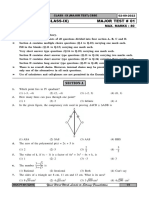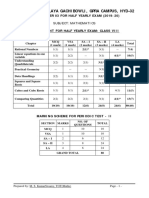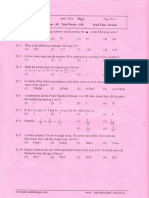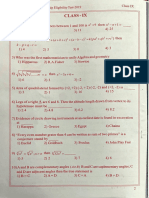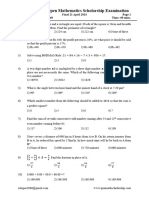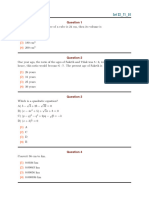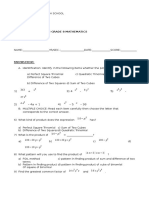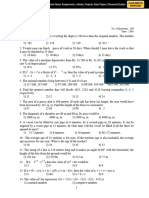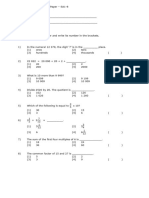Instructions:: Narayana Group of Schools
Instructions:: Narayana Group of Schools
Uploaded by
AryaCopyright:
Available Formats
Instructions:: Narayana Group of Schools
Instructions:: Narayana Group of Schools
Uploaded by
AryaOriginal Description:
Original Title
Copyright
Available Formats
Share this document
Did you find this document useful?
Is this content inappropriate?
Copyright:
Available Formats
Instructions:: Narayana Group of Schools
Instructions:: Narayana Group of Schools
Uploaded by
AryaCopyright:
Available Formats
CLASS-IX CODE-S1300919
Max. Time : 120 Min AARAMBH Max. Marks : 320
Instructions:
i. The test paper consists of 80 multiple choice questions numbered from 1 to 80, each question
followed by four alternatives 1, 2, 3 and 4.
ii. Mental Ability 1 to 20, Mathematics 21 to 35, Physics 36 to 50 and Chemistry 51 to 65,
Biology 66 to 80.
iii. Each question has only one correct option.
iv. (a) Each correct answer carries +4 Marks.
(b) For each wrong answer 1 mark will be deducted.
MAT (Q.NO.1 TO 20)
Directions (Q.No : 1-2): Find the missing term in the given number series:
1. 5824, 5242,?, 4247,3823
1) 4467 2)4718 3) 4856 4) 5164
2. 240,?, 120,40,10,2
1) 180 2) 240 3) 420 4) 480
3. Find the missing term in the given letter series:
Q1F, S2E, U6D, W21C, ?
1) Y44B 2) Y66B 3) Y88B 4) Z88B
4. If RED is coded as 6720, then how would GREEN be coded?
1) 1677199 2) 1677209 3) 16717209 4) 9207716
5. Directions: The sheet of paper shown in the figure (X) Choose from amongst the
alternatives the boxes that are similar to the box that will be formed.
1) A, B and C only 2) B and C only 3) A, C and D only 4) B, C and D only
6. Aman is 16th from the left end in a row of boys and Vivek is 18th from the right end. Gagan
is 11th from Aman towards the right and 3rd from Vivek towards the right end. How many
boys are there in the row?
NARAYANA GROUP OF SCHOOLS Page 1 of 12
CLASS-IX CODE-S1300919
1) 40 2) 42 3) 48 4) 41
Directions(Q. No :7-8 ) : Study the number series given below and answer the questions
that follow:
A person is asked to put in a basket one apple when ordered ‘One’, one guava when
ordered ‘Two’, one orange when ordered ‘Three’ and is asked to take out from the basket
one apple and one guava both when ordered ‘four’.
The order sequence executed by the person is as follows:
1 2 3 3 2 1 4 2 3 1 4 2 2 3 3 1 4 1 1 3 2 3 4
7. How many fruits will be there in the basket at the end of the above order sequence?
1) 10 2) 11 3) 12 4) 13
8. How many guavas will be there in the basket at the end of the above order sequence?
1) 1 2)2 3)3 4) 4
Directions (Q.No-9 to 10) : The following questions are based on the diagram given below.
1) The rectangle represents government employees.
2) The triangle represents urban people.
3) The circle represents graduates.
4) The square represents clerks.
9. Which of the following statements is true?
1) All government employees are clerks.
2) Some government employees are graduate as well as clerks.
3) All government employees are graduates.
4) All clerks are government employees but not graduates.
10. Choose the correct statement:
1) Some clerks are government employees.
2) No clerks in urban.
3) All graduates are urban.
NARAYANA GROUP OF SCHOOLS Page 2 of 12
CLASS-IX CODE-S1300919
4) All graduates are government employees.
11. A child is looking for his father. He went 90 metres in the east before turning to this
right. He went 20 metres before turning to his right again to look for his father at his
uncle’s place 30 metres from this point. His father was not here. From there, he went
100 metres to his north before meeting his father in a street. How far did the son meet
his father from the starting point?
1) 80 metres 2) 100 metres 3) 140 metres 4) 260 metres
Directions (Q.No-12) : The below question, which one of the four interchanges in signs
and numbers would make the given equation correct?
12. In an imaginary language, the digits 0, 1, 2, 3, 4, 5, 6, 7, 8 and 9 are substituted by a, b, c,
d, e, f, g, h, i, and j. And 10 is Written as ba. THEN ( cd + ef ) bc is equal to
1) 684 2) 816 3) 916 4) 1564
Directions (Q. No-13 to 14): Find the missing character from among the given
alternatives.
13.
1) 5 2) 6 3) 8 4) 9
14.
1) 27 2) 33 3) 41 4) 47
Directions (Q. No-15) : Read the following information carefully and
answer the question given below:
i) 'P Q ' means ‘P is the father of Q’;
ii) 'P− Q ' means ‘P is the sister of Q’;
iii) 'P+ Q ' means ‘P is the mother of Q’;
iv) 'P Q ' means ‘P is the brother of Q’;
15. Which of the following represents ‘R’ is niece of M’?
NARAYANA GROUP OF SCHOOLS Page 3 of 12
CLASS-IX CODE-S1300919
1) M K T − R 2) M − J + R − N
3) R − M T W 4) cannot be determined
Directions (Q.No-16) : Count the number of squares and triangles in the following
figures
16.
1)36 triangles, 7 squares 2) 38 triangles, 9 squares
3) 40 triangles, 7 squares 4) 42 triangles, 9 squares
17. Directions : Mirror Images
1) a 2) b 3) c 4) d
18. Directions : Water Images
1) a 2) b 3) c 4) d
19. Directions : Figure Series
1)1 2) 2 3) 3 4) 4
20. Directions : Embedded Figure
NARAYANA GROUP OF SCHOOLS Page 4 of 12
CLASS-IX CODE-S1300919
1) a 2) b 3) c 4) d
MATHEMATICS (Q.NO.21 TO 35)
21. The value of 10 + 25 + 108 + 154 + 225 is:
1) 4 2) 6 3) 8 4) 10
12
22. 3 4 =?
125
2 3 4 2
1) 1 2) 1 3) 1 4) 2
5 5 5 5
23. Which of the following expressions are exactly equal in value?
(
i) ( 3x − y ) − 5x2 − 2 xy
2
)
ii) ( 2x − y )
2
iii) ( 2 x + y ) − 2 xy
2
iv) ( 2 x + 3 y ) − 8 y ( 2 x + y )
2
1) i and ii only 2) i, ii and iii only 3) ii and iv only 4) i, ii and iv only
2
−1 4
−1
( 625 ) 2
24.
= _________
1) 4 2) 5 3) 2 4) 3
25. Factorise: ab ( c 2 + 1) + c ( a 2 + b 2 )
1) ( ab + c )( a + bc ) 2) ( ac + b )( ab + c ) 3) ( a + bc )( ac + b ) 4) ( a + b )( ac + b )
2 x + 3 3x − 1
26. The solution of = is
2 x − 1 3x + 1
1 −1 8 −8
1) 2) 3) 4)
8 8 3 3
27. If the length and width of a rectangular garden plot were each increased by 20 present,
then what would be the percent increase in the area of the plot?
1) 20% 2) 24% 3) 36% 4) 44%
28. HCF of the polynomials 20x 2 y ( x 2 − y 2 ) and 35xy 2 ( x − y ) is:
1) 5x 2 y 2 ( x − y ) 2) 5xy ( x − y ) 3) 5x 2 y 2 ( x + y ) 4) 5xy ( x 2 − y 2 )
NARAYANA GROUP OF SCHOOLS Page 5 of 12
CLASS-IX CODE-S1300919
29. If BOC : COD : AOD = 4 : 2 : 3, where OP, OQ, OR are bisectors of angles
BOC, COD and AOD , then POR is
Q
D C
R P
A B
O
1) 130 2) 180 3) 140 4) 110
30. In the figure given below, AB ||CD and F = 30. Then ECD is
F
o
30
E
A B
C D
1) 130 2) 120 3) 150 4) 60
31. Triangle formed by joining the midpoints of equal sides of an isosceles triangle is
1) Isosceles 2) equilateral 3) scalene 4) Right
32. In a laboratory the count of bacteria in a certain experiment was increasing at the rate of
2.5% per hour, then the bacteria at the end of 2 hours if the count was initially
Rs 5,06,000 is
1) 531616 2) 531606 3) 541606 4) 556160
33. If 14 typists typing 6 hours a day can take 12 days to complete the manuscript of a book,
then how many days will 4 typists, working 7 hours a day, can take to do the same job?
1) 36 days 2) 34 days 3) 32 days 4) 30 days
34. ABCD is a parallelogram; AC and BD are diagonals intersect at O. If OA = 9cm, then
OC is
1) 4cm 2) 3cm 3) 5cm 4) 9cm
35. If the remainder obtained by subtracting a number from its own square is 4 times the
number, what is the number?
1) 4 2) 3 3) 6 4)5
NARAYANA GROUP OF SCHOOLS Page 6 of 12
CLASS-IX CODE-S1300919
PHYSICS (Q.NO.36 TO 50)
36. An observer can see through a pin hole the top end of a thin rod of height h, placed
as shown in the figure. The beaker height is 3h and its radius h. When the beaker
is filled with a liquid up to a height 2h, he can see the lower end of the rod. The
refractive index of the liquid is (Figure not to scale).
5 5 3 3
1) 2) 3) 4)
2 2 2 2
37. A train has just complicated a U-curve in a track which is a semicircle. The
engine is at the forward end of the semi-circular part of the track while the last
carriage is at the rear end of the semi-circular track. The driver blows a whistle
of frequency 200 Hz. Velocity of sound is 340 m/sec. Then the apparent frequency
as observed by a passenger in the middle of a train when the speed of the train is
30 m/sec is
1) 209 Hz 2) 288 Hz 3) 200 Hz 4) 181 Hz
NARAYANA GROUP OF SCHOOLS Page 7 of 12
CLASS-IX CODE-S1300919
38. The tilting of the earth is responsible for
1) Change of days 2) Change of the sun’s rays
3) Change of the season 4) None
39. A particle moves in a straight line with acceleration described by equation given below
v02
a = mx − . If the initial velocity and displacement are (v0, 0) and at any time t0 velocity
x0
and displacement are (0, x0 ) the value of constant m is
v02 v02 2v02 2v02
1) 2) − 3) 4) −
x02 x02 x02 x02
40. A man getting down a running bus falls forward because
1) Due to inertia of rest, road is left behind and man reaches forward
2) Due to inertia of motion upper part of body continues to be in motion in forward
direction while feet come to rest as soon as they touch the road
3) He leans forward as a matter of habit
4) Of the combined effect of all the three factors stated
41. Acceleration due to gravity on moon is 1/6 of the acceleration due to gravity on earth. If
5
the ratio of densities of earth ( m ) and moon ( e ) is e = then radius of moon Rm
m 3
in terms of Re will be
5 1 3 1
1) Re 2) Re 3) Re 4) Re
18 6 18 2 3
42. The sharpness of television image is termed as its
1) Clarity 2) colour 3) resolution 4) graphics
43. Voice box or larynx of human process
1) Sound 2) Wind 3) Loudness 4) None
44. What will be the effect of temperature on speed of sound?
1) The speed of sound decreases with the increases of temperature of the medium.
2) The speed of sound decreases with the decrease of temperature of the medium.
3) The speed of sound increases with the decrease of temperature of the medium.
4) The speed of sound increases with the increase of temperature of the medium.
45. Which is the brightest star in the night sky?
1) Sirius 2) Vega 3) Alpha Centauri 4) Proxima Centauri
46. The different group of stars is known as
1) Constellations 2) Celestial bodies 3) Asteroids 4) Comet
NARAYANA GROUP OF SCHOOLS Page 8 of 12
CLASS-IX CODE-S1300919
47. In the case of a rectilinear uniform motion, distance-time graph is a
1) Parabola 2) straight line 3) curved line 4) rectangle
48. A solid ball, a cylinder, and a hollow ball all have the same mass m and radius R. They
are allowed to roll down a hill of height H without slipping. How fast will each be moving
on the level ground?
2mgH 8mgH 2mgH 2mg
1) 2) 3) 4)
1 1 m 1
m+ 2 m+ 2 1+ 2 m+ 2
R R R R
49. A boy sitting on the topmost berth in the compartment of a train which is just
going to stop on a railway station, drops an apple aiming at the open hand of his
brother sitting vertically below his hands at a distance of about 2 meter. The apple
will fall
1) Precisely on the hand of his brother
2) Slightly away from the hand of his brother in the direction of motion of the train
3) Slightly away from the hand of his brother in the direction opposite to the direction
of motion of the train
4) None of the above
50. This test paper is sitting at rest on your desk. Which of the following statements best
describes this situation?
1) There are no forces acting on your paper.
2) Your paper pushes on the desk only.
3) The desk pushes on your paper only
4) The forces acting on the paper are balanced.
CHEMISTRY (Q.NO.51 TO 65)
51. Coal is of
1) 3-types 2) 4-types 3) 1-type 4) 2-types
52. The type of combustion in which material burns rapidly and produces heat and light is
called_______
1) Rapid combustion 2) Not a combustion
3) Very slow combustion 4) None of these
53. The physical state of water in the polar ice caps and glaciers is
1) Liquid 2) Gas 3) Solid 4) None of these
54. Which of the following is a basic oxide?
1) Na 2O 2) SO 2 3) NO2 4) ClO2
NARAYANA GROUP OF SCHOOLS Page 9 of 12
CLASS-IX CODE-S1300919
55. In a ______________ mixture the components of mixture are uniformly distributed,
throughout it.
1) Heterogeneous mixture 2) Homogeneous mixture
3) Solid mixture 4) Suspensions
56. Bauxite is
1) Al2 O3 .2 H 2 O 2) MgCO3 3) CaCO3 4. ZnS
57. The metal present in haemoglobin is
1) Mg 2) Co 3) Cu 4) Fe
58. Example of Heterogeneous mixture
1) Naphthalene & Water 2) Salt & Water
3) Sugar & Water 4). Alcohol & Water
59. During the formation of coal, which form of the coal is formed at last
1) Peat 2) Anthracite 3) Lignite 4) Bituminous
60. The amount of heat energy produced on complete combustion of 1kg of fuel is called the
___________ of that fuel.
1) Calorific value 2) Isothermic value 3) capacity 4) None of these
61. Tincture of Iodine which is used as an antiseptic is a/an
1) Compound 2) Pure substance 3) Mixture 4) Element
62. In which zone of the candle flame vaporized wax complete combustion takes place due
to good supply of air?
1) Yellow 2) Red 3) Blue 4) outside the zone
63. The Homogeneous mixture of two or more substances from which we cannot separate
its components by the process of filtration is called a ______________
1) Solution 2) Solvent 3) Solute 4) All of these
64. Which one of the following is used for making shoe polish?
1) Paraffin wax 2) petrol 3) diesel 4) lubricating oil
65. Among the following which metal form super oxide?
1) Na 2) K 3) Mg 4) Zn
BIOLOGY (Q.NO.66 TO 80)
66. Red Data Book is published by:-
1) WWP 2) IUCN 3) UNO 4) BSI
67. Part of earth which supports the biodiversity is called
1) Biosphere 2) Sanctuary 3) Ecosystem reserve 4) Biotic community
68. The species which are at the verge of the extinction
1) Endemic 2) Extinct 3) Endangered 4) Exotic
69. 2 - 4D is a
1) Pesticides 2) Insecticides 3) Fungicides 4) Weedicides.
NARAYANA GROUP OF SCHOOLS Page 10 of 12
CLASS-IX CODE-S1300919
70. Match the microorganisms given in the Column A to the group to which they belong in
Column B
1) a-iv, b-iii, c-i.ii 2) a-iv, b-iii, c-ii.i 3) a-iv, b-ii, c-i.iii 4) a-ii, b-iv, c-i.ii
71. BCG vaccination can prevent
1) Cholera 2) tuberculosis 3) hepatitis 4) HIV
72. Which of the following statements about reproduction in humans is correct?
1) Fertilisation takes place externally.
2) Fertilisation takes place in the testes.
3) During fertilisation egg moves towards the sperm.
4) Fertilisation takes place in the human female.
73. In human beings, the correct sequence of events during reproduction is
1) Gamete formation, fertilisation, zygote, embryo
2) Embryo, zygote, fertilisation, gamete formation
3) Fertilisation, gamete formation, embryo, zygote
4) Gamete formation, fertilisation, embryo, zygote
74. Which of the following is true regarding colourless plastid of the cell?
1) Chloroplasts performs photosynthesis
2) Leucoplasts performs respiration
3) Chromoplasts are involved with protection from sunlight
4) Leucoplasts help in the storage of Food
75. An animal cell, a plant cell and a bacterium share the following structural features:
1) Cell membrane, endoplasmic reticulum, vacuoles
2) Cell wall, plasma membrane, mitochondria
3) Cell wall, nucleus, cytoplasm
4) Plasma membrane, cytoplasm, ribosomes
76. Match the following
Column – A Column – B
(a) Electric impulse (i) Skin
(b) Filling of space inside the organs (ii) Cartilage
(c) Adipose tissue (iii) Areolar tissue
(d) Surface of joints (iv) Nervous tissue
(e) Stratified squamous epithelium (v) Subcutaneous layer
NARAYANA GROUP OF SCHOOLS Page 11 of 12
CLASS-IX CODE-S1300919
1) a-iv, b-iii, c-v, d-ii, e-i 2) a-v, b-iii, c-iv, d-ii, e-i
3) a-v, b-iii, c-iv, d-i, e-ii 4) a-iv, b-ii, c-v, d-iii, e-i
77. Synthesis, packaging and movement of proteins in the cells take place in the following
organelles respectively
1) Ribosomes → Endoplasmic reticulum → Golgi bodies
2) Golgi bodies → Endoplasmic reticulum → Ribosomes
3) Endoplasmic reticulum → Golgi bodies → Ribosomes
4) Ribosomes → Golgi bodies → Endoplasmic reticulum
78. Jersey and Brown Swiss are
1) Exotic breeds of cattle having short lactation periods
2) Exotic breeds of cattle having longer lactation periods
3) Desi (Local) breeds of cattle having longer lactation periods
4) Desi (Local) breeds of cattle having short lactation periods
79. What are the desired agronomic characters for fodder and cereal crops they would opt
for?
a) Tallness desired in cereal crops.
b) Profuse branching for fodder crops
c) Variety resistance to biotic stress a good factor to improve crops
d) Shorter duration of crops from sowing to harvesting
1) a, b,& c 2) b & c 3) b, c & d 4) a, b, c
80. Given below are figures of three kinds of muscle fibres, which one/ones would you find in
our legs?
.
1) A only 2) B only 3) A and C 4) B and C
****ALL THE BEST******
www.narayanaschools.in
NARAYANA GROUP OF SCHOOLS Page 12 of 12
CLASS-IX CODE-S1300919
NARAYANA GROUP OF SCHOOLS Page 13 of 12
You might also like
- ISA Samples Writing G7 - 10Document42 pagesISA Samples Writing G7 - 10taengooNo ratings yet
- Instructions:: Narayana Group of SchoolsDocument12 pagesInstructions:: Narayana Group of SchoolsRafi MohammedNo ratings yet
- 8th CLASS 1Document8 pages8th CLASS 1vrswglNo ratings yet
- Major-01 - Maths - Class 9Document4 pagesMajor-01 - Maths - Class 9Pranoy MazumdarNo ratings yet
- Maths Class Ix Session Ending Final Exam Sample Paper 02 2020 21Document9 pagesMaths Class Ix Session Ending Final Exam Sample Paper 02 2020 21Psy KoTeaYenNo ratings yet
- NMMS RT-1 em (30.10.23)Document4 pagesNMMS RT-1 em (30.10.23)Selva KumarNo ratings yet
- MTSE final 2022-23 class 6 checkedDocument7 pagesMTSE final 2022-23 class 6 checkedPoornimaNo ratings yet
- AP Icet Old PapersDocument22 pagesAP Icet Old PapersSudheer VegullaNo ratings yet
- NMMS Ut-5 em (10.11.23)Document4 pagesNMMS Ut-5 em (10.11.23)Selva KumarNo ratings yet
- 8th Class 2Document7 pages8th Class 2vrswglNo ratings yet
- Prebrd I CL X MATHS 2020-21 Set ADocument7 pagesPrebrd I CL X MATHS 2020-21 Set Asameerahmed.orgNo ratings yet
- Quizizz - Number Patterns WilbertDocument8 pagesQuizizz - Number Patterns WilbertFernando SilabanNo ratings yet
- Blueprint (Clss 7)Document3 pagesBlueprint (Clss 7)Ambika RaniNo ratings yet
- half yearly exam 8 2024Document3 pageshalf yearly exam 8 2024dheraj9127No ratings yet
- Maths Class VIII Half Yearly Exam Revised Sample Paper 03Document6 pagesMaths Class VIII Half Yearly Exam Revised Sample Paper 03Bhavya JangidNo ratings yet
- 8th Mega Final 2022Document2 pages8th Mega Final 2022Nikita AgrawalNo ratings yet
- Aimed - 10th Class - QP - 2018Document8 pagesAimed - 10th Class - QP - 2018saicharanghantasala64No ratings yet
- Class 8 Maths Sample Paper - 1Document47 pagesClass 8 Maths Sample Paper - 1anhadsingh79No ratings yet
- Maths Practice QuestionsDocument5 pagesMaths Practice QuestionsKiyotakaNo ratings yet
- Maths Class VIII Half Yearly Exam Sample Paper 03Document5 pagesMaths Class VIII Half Yearly Exam Sample Paper 03Latha RajaiyanNo ratings yet
- Maths Class Vii Half Yearly Exam Revised Sample Paper 02Document6 pagesMaths Class Vii Half Yearly Exam Revised Sample Paper 02Sonali SinghNo ratings yet
- Ipm STD 4, April-2016 PDFDocument4 pagesIpm STD 4, April-2016 PDFSHRILA DASNo ratings yet
- Maths Class Ix Session Ending Final Exam Sample Paper 03 2020 21Document8 pagesMaths Class Ix Session Ending Final Exam Sample Paper 03 2020 21Psy KoTeaYenNo ratings yet
- Diagnostic Test in Math 10Document3 pagesDiagnostic Test in Math 10アレリア あっェルあ100% (1)
- 5th IPM Final Paper 2023Document6 pages5th IPM Final Paper 2023tinku913084No ratings yet
- 9th CLASS 2Document8 pages9th CLASS 2vrswglNo ratings yet
- Grade 8 Maths SAII Final PDFDocument7 pagesGrade 8 Maths SAII Final PDFsinghaladvika9No ratings yet
- CAT 2008 Question Paper With SolutionDocument40 pagesCAT 2008 Question Paper With SolutionManikanth TalakokkulaNo ratings yet
- CAT 2008 Question Paper With SolutionDocument40 pagesCAT 2008 Question Paper With Solutionsarthak sharmaNo ratings yet
- Practice Exam Math 7Document2 pagesPractice Exam Math 7Adrian Richard SalazarNo ratings yet
- 5th 2023-2024 Final PaperDocument4 pages5th 2023-2024 Final PaperCA Vaishali JainNo ratings yet
- RRB-GD (Mathematics) Set 22 - T1 - 01: B B X X X P Q Q PQ P XDocument28 pagesRRB-GD (Mathematics) Set 22 - T1 - 01: B B X X X P Q Q PQ P XdarandgdNo ratings yet
- 5th IPM 2022 PaperDocument5 pages5th IPM 2022 PaperNamita B SaneNo ratings yet
- Maths WorksheetsDocument10 pagesMaths Worksheetsgovimano100% (1)
- Algebraic ExpressionsDocument19 pagesAlgebraic Expressionsmanisha senapathyNo ratings yet
- Ntse Phase - I: Mat (Paper # 02)Document19 pagesNtse Phase - I: Mat (Paper # 02)ketan sumanNo ratings yet
- Computer ScienceDocument3 pagesComputer Sciencetikadarrajesh2115No ratings yet
- STD3 2021 4th JulyDocument3 pagesSTD3 2021 4th JulyRatnesh KumarNo ratings yet
- 8th Standard 2022Document5 pages8th Standard 2022nishakagliwal6No ratings yet
- Class X Maths Revision Test-1 12-Feb 2021Document6 pagesClass X Maths Revision Test-1 12-Feb 2021raghuNo ratings yet
- Ix MathsDocument2 pagesIx Mathsanveksha457No ratings yet
- GRT-4 VIDocument9 pagesGRT-4 VIdashwanth9No ratings yet
- First Periodic Test in Grade 8 Mathematics: 1) 343 + X 3) 4 X - 9 y 5) X - 27 Z 2) 4 A - 4a + 1 4) X - 5 - 36Document4 pagesFirst Periodic Test in Grade 8 Mathematics: 1) 343 + X 3) 4 X - 9 y 5) X - 27 Z 2) 4 A - 4a + 1 4) X - 5 - 36Lhot Bilds SiapnoNo ratings yet
- 8-MathematicsDocument7 pages8-Mathematicsglitchman668No ratings yet
- $RXPVGWCDocument3 pages$RXPVGWCangelamaina001No ratings yet
- Maths Class Ix Session Ending Final Exam Sample Paper 01 2020 21Document8 pagesMaths Class Ix Session Ending Final Exam Sample Paper 01 2020 21Psy KoTeaYenNo ratings yet
- Asm 16417Document6 pagesAsm 16417mohd. bilalNo ratings yet
- Sample QuestionsDocument10 pagesSample QuestionsNibeditNahak100% (1)
- Ipm STD 4 2014 PDFDocument4 pagesIpm STD 4 2014 PDFSHRILA DAS100% (1)
- 02-04-2024 - ALL SENIORS - KCET GT - (ON 1st YEAR SYLLABUS) - MATHS - Q.PAPERDocument6 pages02-04-2024 - ALL SENIORS - KCET GT - (ON 1st YEAR SYLLABUS) - MATHS - Q.PAPERnikhil sridharaNo ratings yet
- SST Class 8Document4 pagesSST Class 8madhukarsingh2854No ratings yet
- TANCET MCA Entrance Sample Question Paper With AnswersDocument12 pagesTANCET MCA Entrance Sample Question Paper With Answersdarklord777373No ratings yet
- 11th CBSE Applied Mathematics 24-25 Half Yearly (Que)Document4 pages11th CBSE Applied Mathematics 24-25 Half Yearly (Que)sanchitjain5134No ratings yet
- MCQ Class 8 MathsDocument41 pagesMCQ Class 8 Mathsneomatrix70100% (2)
- Model Papaer Foundation Class 7Document10 pagesModel Papaer Foundation Class 7delbertradbert12No ratings yet
- NTSE Test Series (Stage-II)Document38 pagesNTSE Test Series (Stage-II)QSQFNo ratings yet
- Worksheet Mid TermDocument3 pagesWorksheet Mid TermAryan JaiswalNo ratings yet
- Sample category 2Document6 pagesSample category 2ASMR Chinese ChineseNo ratings yet
- P4M-SA1-8Document11 pagesP4M-SA1-8Ang AngNo ratings yet
- (WWW - Entrance-Exam - Net) - TANCET MCA Model Paper 1Document12 pages(WWW - Entrance-Exam - Net) - TANCET MCA Model Paper 1mrsagbNo ratings yet
- Antentop 2014-01Document120 pagesAntentop 2014-01Black OnionNo ratings yet
- A Study On Making Organic Room Freshners Diffusers For HotelsDocument42 pagesA Study On Making Organic Room Freshners Diffusers For HotelsMae ann CumpletoNo ratings yet
- Lecture 18: Maximum and Minimum Values and The Mean Value TheoremDocument6 pagesLecture 18: Maximum and Minimum Values and The Mean Value TheoremShiraz NajatNo ratings yet
- Riopipeline2019 1112 FM 1112 FinalDocument10 pagesRiopipeline2019 1112 FM 1112 FinalMarcelo Varejão CasarinNo ratings yet
- Tax Card 2022Document2 pagesTax Card 2022abdullahsaleem91100% (1)
- Unit2 1Document23 pagesUnit2 1Ferdian SuryaNo ratings yet
- Mid1 Question BankDocument3 pagesMid1 Question Bankarjunkarna2898No ratings yet
- Injection Molding SchematicDocument15 pagesInjection Molding SchematicSourav DipNo ratings yet
- Background of TDocument2 pagesBackground of Telias ferhanNo ratings yet
- 327 Profnotes 01 AllDocument100 pages327 Profnotes 01 AllReinold NdreuNo ratings yet
- Akshata Mulay: ExperienceDocument3 pagesAkshata Mulay: ExperienceNaveenJainNo ratings yet
- Module 6 - Types of SpeechDocument30 pagesModule 6 - Types of SpeechZiana Ross HampacNo ratings yet
- Evidence-Based Labor Management - Induction of Labor (II) AJOG Nov-2020Document11 pagesEvidence-Based Labor Management - Induction of Labor (II) AJOG Nov-2020Andrea SerranoNo ratings yet
- Manifest NonUFSFiles Win64Document16 pagesManifest NonUFSFiles Win64C.K. ReviewsNo ratings yet
- 05 Brute ForceDocument56 pages05 Brute ForcejojoNo ratings yet
- Appwidget History Log1Document3 pagesAppwidget History Log1shammahmsy40No ratings yet
- Matching (Part 2)Document9 pagesMatching (Part 2)adauNo ratings yet
- Incident Investigation Report-LBernacer Car Crash IncidentDocument6 pagesIncident Investigation Report-LBernacer Car Crash IncidentNelz PelaezNo ratings yet
- Accelerating Growth - Strategic Approach On Dynamic Pricing in BankingDocument2 pagesAccelerating Growth - Strategic Approach On Dynamic Pricing in BankingsuntecsolutionssNo ratings yet
- Transformer Testing 3Document1 pageTransformer Testing 3imcoolmailme2No ratings yet
- Chemical Blasting Prior Approval PDFDocument1 pageChemical Blasting Prior Approval PDFPradeep KumaraNo ratings yet
- Tangents and Secants of A CircleDocument24 pagesTangents and Secants of A CircleRita Alacquiao - Mangiga100% (1)
- FLENDER Standard CouplingsDocument278 pagesFLENDER Standard Couplingsalfredo_fredo_1No ratings yet
- 722.6 - Transmission Model YearsDocument5 pages722.6 - Transmission Model Yearsyared abebeNo ratings yet
- Article - Drilling For Insights PDFDocument4 pagesArticle - Drilling For Insights PDFNishant SutarNo ratings yet
- Budidaya Tumbuhan ObatDocument31 pagesBudidaya Tumbuhan ObataditaNo ratings yet
- Learning Guide: Basic Account Works Level IIDocument29 pagesLearning Guide: Basic Account Works Level IIBeka AsraNo ratings yet
- National Stock Exchange: Financial Market Regulations Project OnDocument11 pagesNational Stock Exchange: Financial Market Regulations Project OnNehmat SethiNo ratings yet
- 1 s2.0 S0020768307001837 MainDocument24 pages1 s2.0 S0020768307001837 MainGregory HopkinsNo ratings yet



